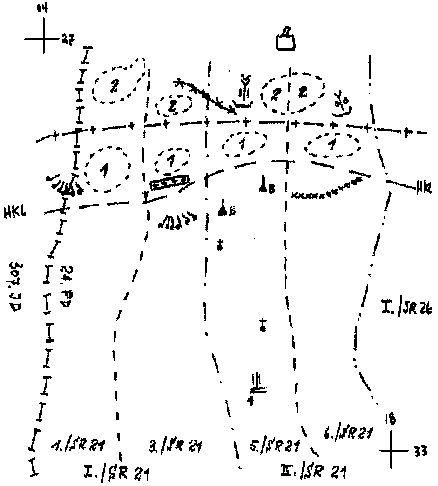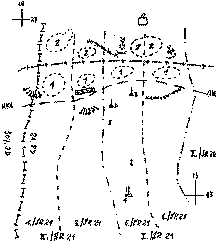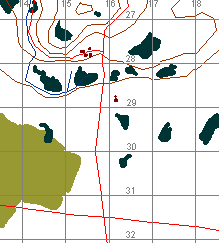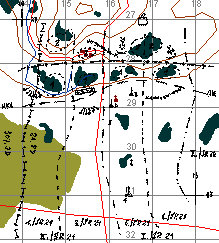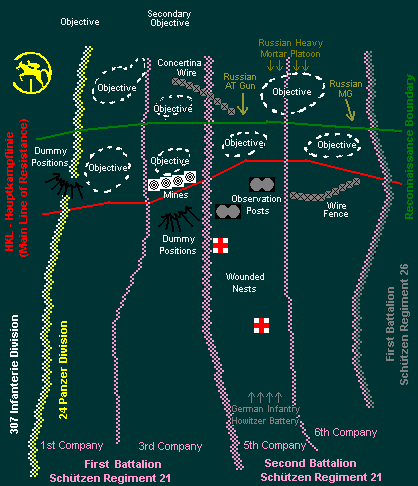| The
following article was written by Lou Brown and originally printed in Volume IV, Number 5
(Sep-Oct 1994) of Kettenhunde, the newsletter of a re-enactment group in the
northern United States who portrayed Feldgendarmerie-Trupp (Mot.) 200. Some sections
have been rewritten by the webmaster. In "war movies," battle plans are usually laid out by the hero in a half minute of generalized pontification followed by the memorable phrase: "You all know what we have to do, now let's go do it." In real life, the truth is that everyone doesn't know what to do, and a mechanism for telling them what to do, as well as when (and, to some extent, how) is very necessary for effective fighting. Modern armies utilize the "field operations order" as an effective method of ensuring the coordination necessary for effective fighting. A derivative of Napoleon's field orders, the modern operations order contains those elements of information necessary to synchronize and conduct the fight. The German approach to operations having been somewhat "individualistic" (ie, the subordinate was expected to achieve the mission given to him in his own way), German operations orders tend to be somewhat less structured that those used in the US Army. Somewhere in the order, the following elements (considered the minimum necessary for the conduct of operations) were supposed to be addressed:
Often, "full" orders were not necessary (eg, when updating or slightly changing a mission). The organization of the partial order (called a FRAGO -- fragmentary order -- in US usage) is the same, except that elements are omitted which either have not changed or are not necessary to the order. The operations order was accompanied by a "Schema" (diagram, in English). In English, this is now referred to as an "overlay" because it is drawn on a transparent substance and "laid over" the map. The Schema shows, at a minimum, the graphic measures used to control operations (eg unit boundaries, objectives, etc.) as well as known or suspected enemy positions. Operations orders under field conditions are generally given orally (following the format) at battalion level and below and in writing at regiment/brigade and above (written orders are nonetheless "briefed" to those receiving the order if circumstances permit). Orders can be written at any level if time permits, often if only to aid the commander in orally delivering it. What follows - in the format in which it was written - is a translation of an operations order written by Oberleutnant Georg Michael, a company commander in Schützen Regiment 26 for a dismounted attack in the USSR on 28 June 1942. (This regiment was part of the 24th Panzer Division, famous for having been formed from the 1st Cavalry Division. The Schützen regiments were the motorized infantry component of the panzer divisions, and between late 1942 and early 1943 would be renamed as Panzergrenadier regiments. The 24th Panzer Division, with its "leaping horseman" for a divisional emblem, would be destroyed in the fighting at Stalingrad in the seven months following the attack described here). As a unit with cavalry traditions, Michael's regiment was divided into Squadrons rather than Companies, though there was no real distinction in terms of equipment or organization other than the name. Despite only being a set of Squadron orders, Michael still wrote them out, probably simply because he had the time to do so. Explanatory notes follow the translation of the order itself and are indicated in the text by superscript numerals. Oberleutnant Michael won the Knight's Cross on 19 January 1941 and the Oakleaves to the Knight's Cross on 25 January 1943 for actions in Stalingrad, where he was critically wounded and evacuated. He had been promoted to Rittmeister (Hauptmann of a cavalry unit) on 1 December 1942. The action described below did not go exactly as planned - they never do. The most important part of planning is, however, ensuring that everyone understands the mission. While Michael's plan did not unfold as he envisioned it in the order, he and his company nonetheless achieved the objectives assigned them and, thus, fulfilled the intent of the order. Military operations, contrary to popular conceptions, don't just happen. Sample Map Diagram Below is a sample map diagram - this is not the
diagram that would have accompanied Michael's operations order, given below, but shows
what a typical German diagram may have looked like, using period map symbols. |
||||||||||||||||||||||||||||||||||||||||||||||||||||||||||||||||||||||||||
|
||||||||||||||||||||||||||||||||||||||||||||||||||||||||||||||||||||||||||
6./Schützen Regiment 26 Squadron Command Post, 24 Jun 1942 ORDER FOR THE ATTACK AFTER ASSEMBLY
Footnotes 1. Specifying maps is very important to ensuring that everyone is "playing off the same sheet of music." It is very unpleasant to find that the overlay you have been given for an operation doesn't "fit" the map you are using because they are different scales. 2. Standard convention in naming German units was for companies to be identified by arabic numerals (1, 2, 3...), battalions to be identified by Roman numerals (I, II, III), and for regiments to be identified by an abbreviation followed by arabic numbers (JR for Jäger Regiment 23, etc.). Bear in mind that common practice in German handwriting was to write "J" for both "I" and "J", when handwriting on overlays and maps, thus JR would be used for both Infantry Regiment and Jäger Regiment.. This was only partially due to the German handwriting fonts used at the time, according to which these two did not differ in shape but in position. This was taught in schools until the 1950s. The other motive for this was to not confuse Roman letters, which of course uses the capital 'I" very frequently. Since the companies in a regiment were numbered consecutively across the battalions, it was unnecessary to list both company and battalion number. The I Battalion generally contained 1, 2, 3 and 4 Companies, II Battalion 5, 6, 7 and 8 Companies, and where present the III Battalion contained 9, 10, 11 and 12 Companies. Therefore you would only need to designate the Fifth Company as 5./JR 23 or the Second Battalion as II./JR 23. Paragraph 2 gives an easily understood friendly situation; who is on the flanks and what other "friendlies" are doing, as well as the mission of the next higher headquarters in the chain of command. In the US Army it is doctrine to provide the mission for the next two higher echelons - a company order would therefore containg the mission for both the battalion and the regiment. The second objective mentioned in para 2a, "Nordhang 247.7" is a hill. The Germans identified hills by their elevation in metres. In Michael's orders, the name "Nordhang" was an additional identifier assigned to the hill by the Germans themselves. 3. Schützen regiments generally consisted of only two battalions of infantry (1-8 companies) and a third battalion consisting of specialized support weapons (infantry guns, mortars, anti-tank guns, anti-aircraft guns, etc.) In this case, the 9th Company contained sIG, or "schwere Infanterie Geschütz" - heavy Infantry Guns used. Support was also provided by divisional units, in this case the Second Company of Panzer Pionier (Armoured Engineer) Battalion 40, and the First Battalion of Artillery Regiment 89. 4. In infantry/schützen regiments, every fourth company was a heavy weapons company, equipped with mortars and machineguns to support the other three companies of the battalion, hence no reference to the 8th Company - one can presume its weapons would be covering the attack. The reference to light infantry guns (leIG) probably refers to one guns from one of the regimental weapons companies. 5. In paragraph 4, Michael explains how the company will get from their assembly area to the attack position (the last covered and concealed position before "jumping off." The occupation by Brakebusch's platoon affords security for the remainder of the company's move, and the company digs in already arrayed in the attack formation. The order of march prevents the confusion of everyone moving -- or trying to -- at once. 6. Paragraph 6 outlines Michael's "vision" of how the attack will go down. The order is slim on actual details concerning how the action will be fought. This is not unusual in orders to units which have worked together for some time; they develop what almost amount to "plays" as one would find in a sports team ("just like we did it the last time") which are executed depending on the situation's similarity to others the unit has experienced. In this case, whatever attack formation ordered in paragraph 4 placed the units where Michael wanted them and, therefore, tells everything the unit needed to know about "how to fight." The rest of the order addresses items which are not so "routine." 7. Paragraph 7 is interesting in the order to each platoon to deliver 10 blankets to the battalion aid station. Platoon medics set up "wounded nests," a place to which wounded were evacuated to be administered first aid and either returned to the fight or evacuated to the company aid station. 8. Paragraph 8b is extremely interesting. Michael's company was motorized (only the First Battalion was "armoured", that is to say, mounted in armoured halftracks). Since the attack was dismounted, someone had to get the company's vehicles married back up with the troops on the objective (as did the rest of the battalion). The task was important enough for the battalion to assign a Leutnant to take charge of and move the empty trucks. (Assignment of an officer was a sure sign of something being important to the Germans; they didn't have a lot of them, and didn't waste the ones they did have.) 9. Paragraph 9 refers to the amount of illumination during hours of darkness. This is extremely important to a night move. (The US Army uses a percentage, with a moonless night generally about 10-20%; a full moon affords 70-100% illumination.) Given the short night (para 2b) and time of year, one would expect that level V is fairly high. The visibility ratings I through X in Roman numerals were used (Arabic numbers 1-10 were used by the Navy, and in fact also often by the army artillery) corresponding to the standard Meteorological scale in use at the time. The scale was measured in nautical miles (seemeile or sm in German):
Coloured flares were common signalling devices in the German Army and combat leaders carried small handheld flare guns for this purpose. 10. The designation of the "1st bridge in Ssemonowka" as both a POW and Killed in Action collection point is unusual; in the US Army, the two were generally not mixed if for not other reason than to prevent POWs from seeing the effectiveness of their actions. In the Canadian Army, the Company Sergeant Major was generally responsible for POW collection and organizing his company headquarters troops into ensuring ammunition, water, fuel and food flowed forward, and that prisoners and casualties of all types flowed backwards and were properly tended to. 11. The term "schwadronchef" was used similarly to "kompaniechef" in non-mounted units. It designated an officer in command of a company/squadron. If Michael had been only an acting or temporary commander, his title would be "schwadronführer" or Squadron Leader. |
||||||||||||||||||||||||||||||||||||||||||||||||||||||||||||||||||||||||||
